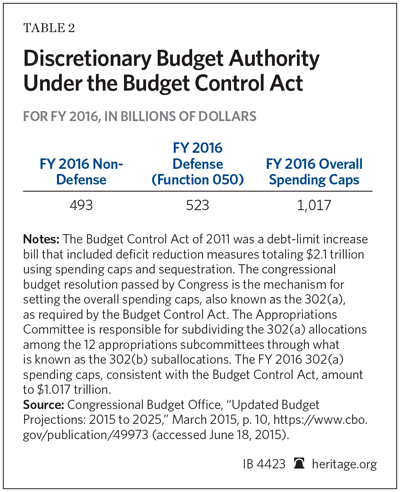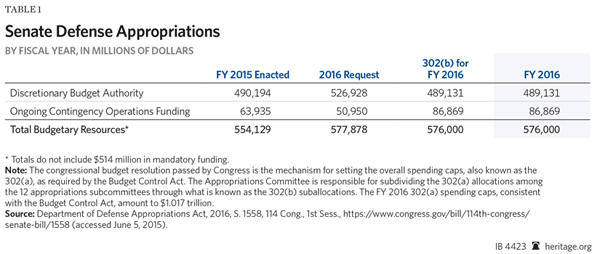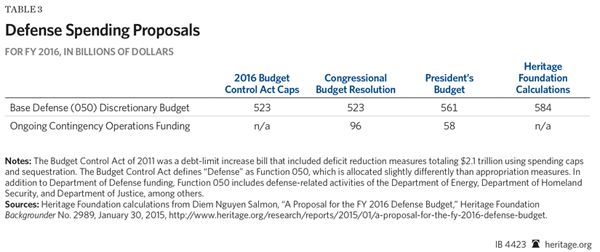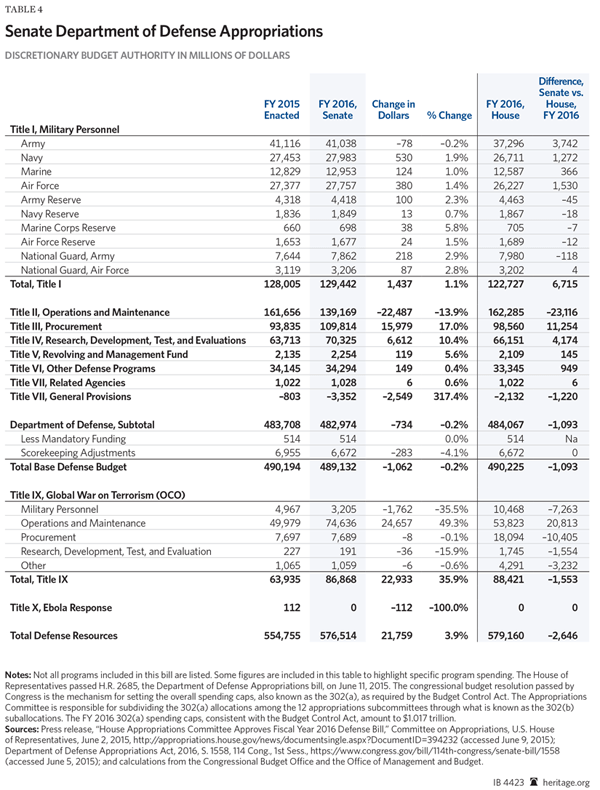This week, the Senate will begin the procedural process to begin debate on the Department of Defense (DOD) appropriations bill. The debate on the Senate bill comes a week after the House of Representatives passed the companion DOD appropriations bill.[1] The Senate bill provides $489 billion, nearly $1 billion less than the House bill. The funding levels provided are nearly the same as current funding, but $38 billion less than the President requested in his budget submission to Congress. However, the bill also provides $86.9 billion for Overseas Contingency Operations (OCO), although $1.5 billion less than the House provided. In total, the Senate DOD appropriations bill provides $576.5 billion in total budget authority—$2.6 billion less than the House DOD bill, but roughly $22 billion more than current funding.
Defense Funding at a Critical Juncture
National security funding is at a critical juncture in Washington. The Budget Control Act (BCA) divides spending into two separate spending categories: defense and non-defense. (See Table 1.) Both are subject to spending caps outlined in the law. Many conservatives believe that by putting disproportionate emphasis on cuts in defense, spending reductions achieved by the BCA have failed to prioritize federal funding adequately.

This categorization provides considerable flexibility in determining domestic, non-defense spending priorities, but allows little flexibility with defense spending. This situation has left conservatives in a catch-22 situation, with legislators caught between their desire to provide enhanced funding for new national security resources and the need to adhere to the spending caps. The DOD appropriations bill can do little to realign spending in the defense or non-defense categories. If this appropriations bill attempted to exceed the spending caps outlined in the BCA, that spending would be subject to sequestration.
To circumvent the spending caps, Congress employs a budget gimmick known as Overseas Contingency Operations (OCO) or war funding, which is meant to provide resources to the ongoing wars in Iraq and Afghanistan. The emergency nature of OCO means that those resources are available without the restrictions of BCA spending limits. The resources needed to fulfill the missions of the war are determined—and requested—by the President.
For fiscal year (FY) 2016, the President requested $58 billion for OCO, $38 billion less than the $96 billion provided by the congressional budget resolution. The $38 billion in OCO funds above the President’s request is not the appropriate way to address national security needs.
The solution to the problem of national security priorities running up against budget caps can be achieved without budget gimmicks or busting the overall BCA budget caps. It would require Congress to renovate the BCA by removing the spending cap firewall between defense and non-defense. Members of Congress could then redirect funds otherwise provided to overreaching, big-government non-defense programs to meet national security priorities.
Defense Budget Recommendations
In March, The Heritage Foundation published The Budget Book: 106 Ways to Reduce the Size and Scope of Government.[2] It includes an analysis of the entire budget with recommendations for reducing funding in some areas of the defense budget, specifically:
- Eliminating non-combat-related medical research. The Senate bill provides $70.3 billion for research, development, testing, and evaluation in FY 2016. Eliminating non-combat-related medical accounts would save at least $500 million.
- Eliminating commissary subsidies. The Senate bill provides $1.5 billion for commissary salaries for FY 2016—roughly $300 million more than current funding.
- Increasing use of performance-based logistics. The Senate bill provides $139.2 billion for operations and maintenance for FY 2016—$22.5 billion less than current funding. Using performance-based logistics in weapon system maintenance and sustainment could save as much as $9 billion.
In January, The Heritage Foundation published “A Proposal for the FY 2016 Defense Budget,”[3] which recommends that Congress:
- Increase national defense spending. The Senate bill provides $489 billion in base DOD spending for FY 2016, roughly the same as current funding.[4] There are two general concepts for “defense” in Congress: One refers to the Department of Defense, as is the case with this bill, and an esoteric budget concept that defines defense as “Function 050.” Function 050 is a defense account that funds not only DOD, but also any security-related spending, including the Department of Energy’s National Nuclear Security Administration. The Function 050 account is subject to a statutory BCA spending cap, which is $523 billion for FY 2016, $489 billion of which in this DOD bill is provided for DOD defense activities as opposed to related security activities. The Heritage Foundation recommends increasing defense funding (Function 050) from $523 billion to $584 billion. The $584 billion funding level would allow increased funding for personnel and force size, procurement and research and development (R&D), and operations as detailed in the next three points.
- Increase personnel and force size funding. The Senate bill provides military personnel $129.5 billion for FY 2016, $1.4 billion more than current funding.
- Increase procurement and R&D funding. The Senate bill provides $109.8 billion for procurement, $16 billion more than current funding.
- Increase operations funding. The Senate bill provides $139.2 billion for operations and maintenance, $22.5 billion less than current funding.
Conclusion
The Senate and House Department of Defense appropriations bills are part of the larger debate over BCA budget cap levels. The BCA limits have forced Congress to ponder the difficult choice between fiscal responsibility and providing adequate national security resources.
After years of unsustainable trillion-dollar deficits, the budget caps put in place by the BCA were arguably the first real step in reining in out-of-control spending. For this reason, Congress cannot afford to stymie progress by meddling with the current overall spending limits. At the same time, conservative Members of Congress are concerned that the funding limits reducing defense spending will jeopardize national security. Balancing the preservation of the overall spending caps and providing new resources to defense is a topic that Congress will continue to face in future spending bills.
—John Gray is a Research Fellow in Federal Fiscal Affairs in the Thomas A. Roe Institute for Economic Policy Studies, of the Institute for Economic Freedom and Opportunity, at The Heritage Foundation.




